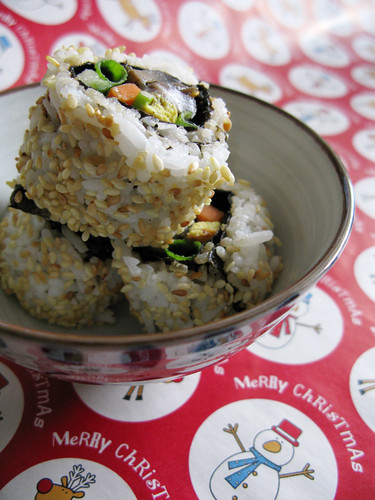Saturday, December 19, 2009
Merry Christmas!
As I have been extremely lazy with my poor blog in the past couple of months, I thought I'd wish the world a merry Christmas!
Saturday, July 25, 2009
Soughdough Bread
So you've been feeding your sourdough bread for the past week, and are now wondering "what now?!" Well for a start, you can add some of your starter to any bread recipe, to make it more interesting. Every time you use it, make sure to replenish what you take, so you've got some for next time!
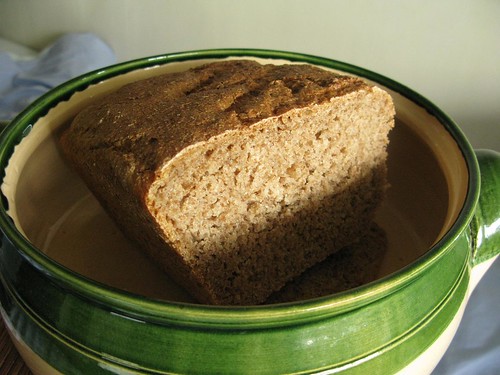
But for something special, look to the classic soughdough recipes. Pane All'olio is a tasty Italian bread, with its distincitive sour characteristics combining nicely with the olive oil. The secret to a great crust on your bread is to cook it in a very hot oven, on an unglazed terracotta tile, and make sure to mist the sides of the oven with water during the first 10 minutes of cooking. If you're lucky, your local tile shop may simply give you one of their tiles. To transport your dough onto the hot tile, its useful to have a "bakers peel" - a thin flat shovel, either wooden or metal. Also a large piece of unbleached linen cloth is a useful item to get hold of, for letting the dough rest in, to give it its shape. Dough tends not to stick to linen, if its well floured. (A tea towel would also work)
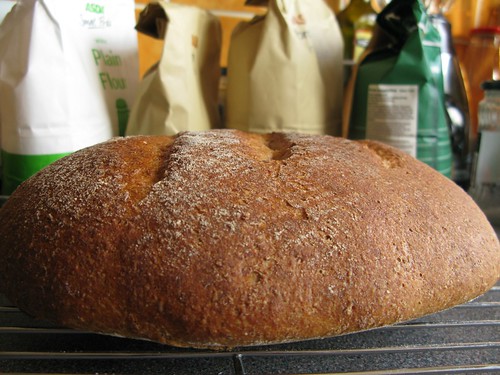
Down to business! Here's how to make another Italian favourite:
Ciabatta
¾ cups / 160ml / 6 fl oz Sourdough Starter
1 cup white flour
¾ cup water
325 g / 11½ oz / 3 cups white flour (I used "brown" for added nutriants. Probably half wholemeal/white would also work, but you may need slightly more water to compensate)
200 ml / 7 fl oz / 1 scant cup tepid water
¼ tsp active dry yeast
½ tsp sugar
30 ml / 2 tbsp soya milk
30 ml / 2 tbsp olive oil
1½ tsp salt
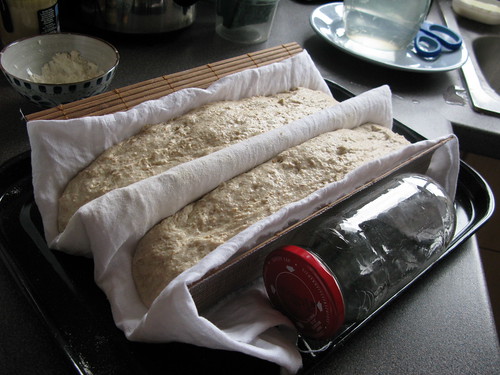

So, armed with a litter of freshly baked ciabatta loaves, I set off this afternoon to a friends house for a Sunday roast. My loaves were promptly cut into slices, and served up with some olive oil and balsamic vinegar, and didn't last long, as we waited for the main dish to be served.
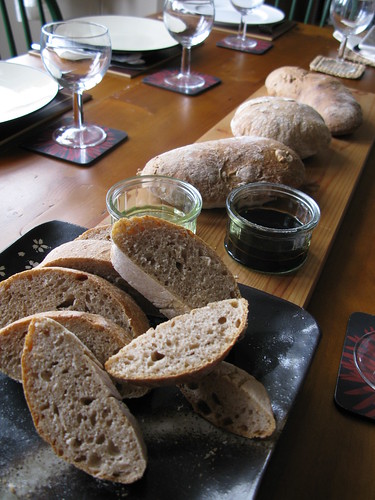
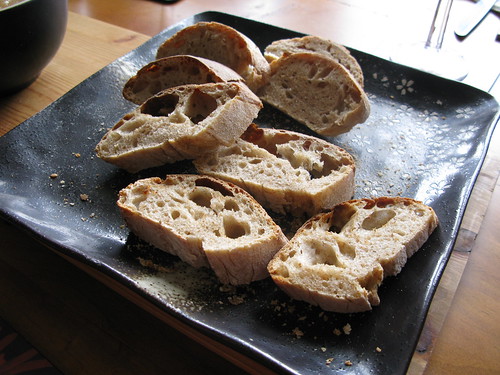
Amy had done a fantastic job with the main course, and I was extremely well catered for. I had roast potatoes and parsnips, stuffed portabello mushrooms, with boiled carrots and french beans on the side, and applesauce on top. For dessert, I had a fruit salad all to myself, full of strawberries, kiwi, orange and apple. Simply delicious!
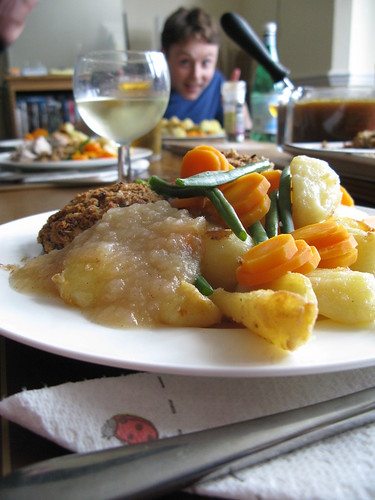
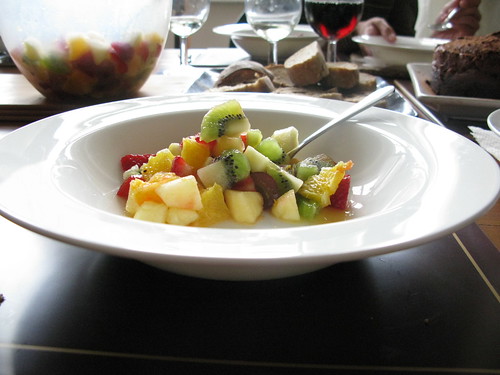
Cheers!
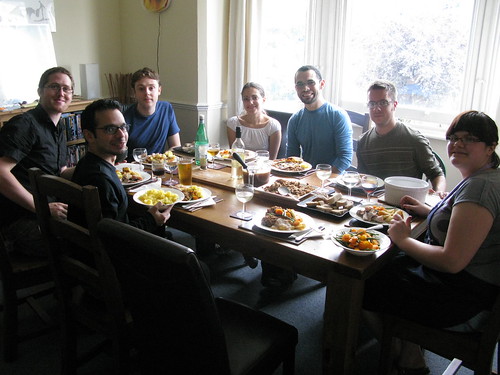

But for something special, look to the classic soughdough recipes. Pane All'olio is a tasty Italian bread, with its distincitive sour characteristics combining nicely with the olive oil. The secret to a great crust on your bread is to cook it in a very hot oven, on an unglazed terracotta tile, and make sure to mist the sides of the oven with water during the first 10 minutes of cooking. If you're lucky, your local tile shop may simply give you one of their tiles. To transport your dough onto the hot tile, its useful to have a "bakers peel" - a thin flat shovel, either wooden or metal. Also a large piece of unbleached linen cloth is a useful item to get hold of, for letting the dough rest in, to give it its shape. Dough tends not to stick to linen, if its well floured. (A tea towel would also work)

Down to business! Here's how to make another Italian favourite:
Ciabatta
¾ cups / 160ml / 6 fl oz Sourdough Starter
1 cup white flour
¾ cup water
325 g / 11½ oz / 3 cups white flour (I used "brown" for added nutriants. Probably half wholemeal/white would also work, but you may need slightly more water to compensate)
200 ml / 7 fl oz / 1 scant cup tepid water
¼ tsp active dry yeast
½ tsp sugar
30 ml / 2 tbsp soya milk
30 ml / 2 tbsp olive oil
1½ tsp salt
- Put the ¾ cups soughdough starter into a large bowl, making sure to replenish your remaining starter with equal amounts of white flour and water.
- To your bowl, add the 1 cup white flour and ¾ cup water, mix well for 10 minutes, folding the mixture using a spoon to try to capture as much air as possible.
- Cover your bowl and leave overnight (at least 12 hours) at room temperature.
- The next day, your soughdough should be healthy and bubbling a little, ready for some leavening action.
- Add the remainder of the flour on top of the starter, and make a well in the centre. Add tepid water to the centre, and then the yeast and sugar, stirring a little to dissolve, and leave the yeast to activate and start to bubble, (15 mins)
- Add the remainder of the ingrediants, and mix into a fairly wet dough. Continue to knead for 10 minutes, trying not to add too much more flour if its too sticky - the dough should be like this.
- Leave in a warm area for 1 hour, until trippled in size.
- Divide into 2 portions, and, trying not to expel too much air, tip dough onto a well floured piece of linen, and gently shape into loaves.
- Preheat your oven, with the baking stone/tile, to 220 degrees celsius.
- Leave to rise for a further 30 mins, then tip each loaf in turn onto your peel, and into the very hot oven, onto your baking stone/tile.
- Mist the sides of the oven with water, and again every 3 minutes for the next 10.
- Bake for a total of 30 minutes, then remove from oven and leave to cool on a wire rack. The underside should sound hollow when tapped.


So, armed with a litter of freshly baked ciabatta loaves, I set off this afternoon to a friends house for a Sunday roast. My loaves were promptly cut into slices, and served up with some olive oil and balsamic vinegar, and didn't last long, as we waited for the main dish to be served.


Amy had done a fantastic job with the main course, and I was extremely well catered for. I had roast potatoes and parsnips, stuffed portabello mushrooms, with boiled carrots and french beans on the side, and applesauce on top. For dessert, I had a fruit salad all to myself, full of strawberries, kiwi, orange and apple. Simply delicious!


Cheers!

Saturday, July 4, 2009
Loafing Around

Walking down the streets of London, a breath of fresh air is an unexpected pleasure, but as I wondered around, past Le Pain Quotidien, I was greeted by the most sensational aroma. Fresh sourdough bread being baked. Its just one of those things that instantly makes you feel warm and fuzzy inside.
For the past couple of months I've been trying to get into bread baking. I've learnt quite a few things, one being that it ain't easy. Baking bread seems to be more science than art, a long way off from my normal kitchen craft of throwing things together, and fixing the taste as you go.
To me, Sourdough bread is the cordon bleu of the breads, so I decided that if I was going to get into baking bread, I may as well aim for the best.
- It gives bread character - plenty of aroma and flavour
- It is essential when trying to make loaves with high percentages of rye flour, good for lower gluten recipes
- The bread last longer, being more resistant to other molds
- Soughdough bread is cheaper to make, as you can reduce, or even remove the amount of yeast the recipe calls for

Making The Sourdough StarterWell, that should keep you busy for around a week, so I've got a bit of time to perfect the best sourdough loaf recipe ever! Stay tuned...
The goal here is to make a batter from flour and water, which is full of yeast and a strain of good bacteria, which can live happily together for years to come, as long as you keep it active.
Start off with a bowl that can hold around 4 cups.
The Chef
0.6ml / 1/8 tsp dried yeast
50g / 2 oz / ½ cup organic white/rye flour
45ml 3 tbsp dechlorinated water
Flour natually contains microorganisms that can help create a good culture in your starter. To give it all the chance it needs, organic flour is best. Rye flour is also a good way of introducting good bacteria to the starter, so substuting in small amounts of rye at the start is a good idea. Tap water contains quite a lot of chlorine which can defeat our good bacteria, allowing bad ones to take hold later on, so either boiling, or leaving water in sunlight for a few hours will help (chloramine is unaffected by these methods, so if you live in one of those areas, it might be harder creating a good starter from scratch).
To make the "Chef": Mix the yeast and flour(s) together in your bowl. Gradually add the water with a metal spoon, and mix to a stiff dough. Cover with oiled cling film, and leave in a warm place for 2 - 3 days.
Break open the crust on the Chef. The middle should be aerated and sweet smelling. Add the "1st refreshment":
The 1st Refreshment
65ml / 4½ tbsp water
115g / 4 oz / 1 cup white flour
Mix in the water and flour to form a fairly stiff dough. Replace film and leave for 2 days in a warm place.
The Levain
115ml / 4 fl oz / ½ cup water
115g / 4 oz / 1 cup white flour
Add water and flour, and knead into a "basic dough". Leave for 8 hours with a damp dish towel to cover, at room temperature. The sourdough starter is now ready to be used in a loaf. Don't use all of it, mind! Whenever you use some (between ½ and ¾ of the starter), you should replenish what you take with equal parts flour and water (by weight)
Using The Starter
When its time to make some bread, take your starter out of the fridge and leave to warm up to room temperature (if storing in the fridge, which is a good idea if you don't make bread every other day or so). Take the quantity needed for the recipe (no more than ¾ of the total), and note the weight that you've removed. Replenish this with equal quantities of water and flour (by weight), and mix into a smooth batter. Leave the starter mixture until it starts to bubble, before returning to the fridge, anywhere between 3 - 8 hours should be fine.
Saturday, June 27, 2009
Barcelona Days 1 and 2
Day 1
Monday morning starts a little hazily, probably as a result of Anke's delicious Baileys-style cocktails that we were drinking into the early hours of Sunday morning. It is still technically the morning after, as 3 hours sleep in a cheap and cheerful youth hostel in the centre of Camdon doesn't really count as a good night's sleep.
There are last minute preparations to be made, before I head out. Water the plants; check passport; learn Catalan; decide what we should do for this upcoming week... I didn't manage to do everything on my list before heading to the airport, but at least the plants didn't feel neglected.
I found out in the airport that politics is about as taboo as talking about the ethics of food, and the best thing to say about nationalism when surrounded by foreigners is nothing. Hypothesizing what would happen if lightning struck a plane in middair seemed to lighten the mood, until torrential rain delayed our plane from taking off.
And then we were off!
There weren't many hours left in the day by time we'd settled into our awesome apartment in the middle of Gràcia, so we didn't stray far for our first round of Estrellas, followed by some food from a place called Ugarit. There seemed to be a reasonable selection of Middle-Eastern-style food here, including falafels and cous cous, and I ended up with a wrap filled mostly with houmous, which is what you get when trying to stress how much you don't want any other sauces, "only houmous". The free shots of beer was a nice touch.
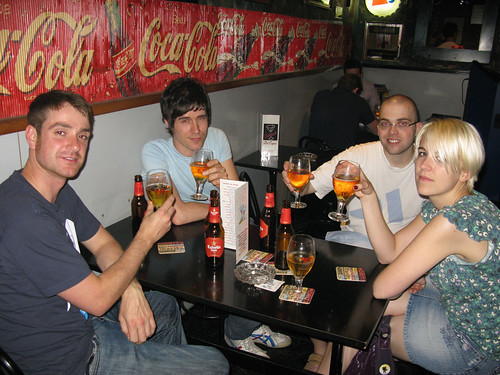

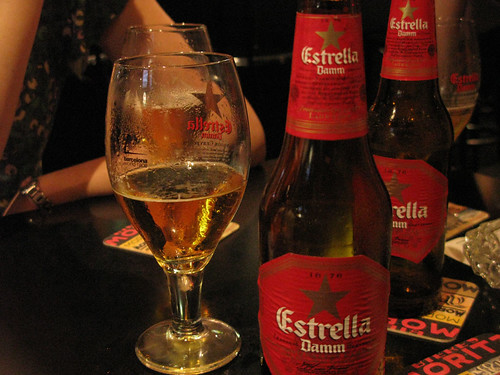
Day 2
We were all up bright and early in the morning, which was a nice change, and the first port of call was the supermarket for some supplies. We'd decided to do a bit of cooking in the apartment, to save on money, and also to accomodate my taste buds, which I definitely appreciated. It was either that, or drag my friends to a vegan restaurant (of which there are plenty in Barcelona), and have them complain about "organic tasting" or "bland" food, or worse, go to a regular restaurant, where I would inevitably get given genuinely bland and organic-tasting food, or simply food I couldn't/wouldn't eat. Cooking at home was definitely the best option, although I was slightly concerned about how much they really cared, when one of them decided to get some unsuitable pasta, saying it was probably OK because it didn't have pictures of eggs on the packaging like the others...

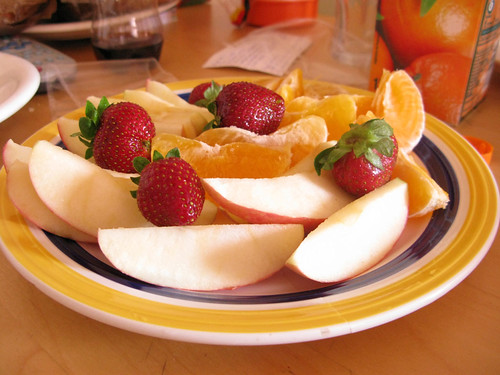
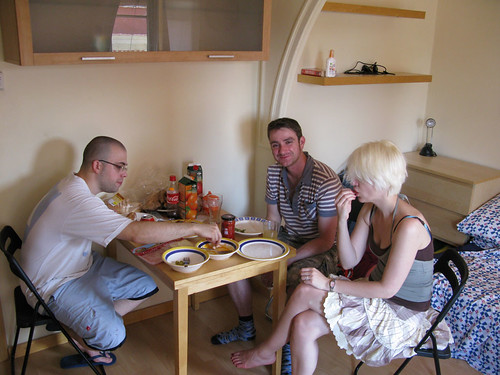
After depositing some extremely heavy shopping, and a quick mid-afternoon snack to keep us going, we headed back into the city making our way from the fountains at Catalunya Square to the Gothic Quarter.

Barcelona is a beautiful city to walk around. Each quarter has its own personality, and to me, the Gothic quarter is exactly how I imagined Barcelona to be, with its narrow cobbled alleys snaking their way around old churches, unique architecture, cafés and bars. Amongst the plethora of artisan bakeries, delicatessens and pharmacies, there just isn't any need for supermarkets. Buying from these tiny shops is a much more tangible experience than self service in a supermarket, or worse, internet shopping.
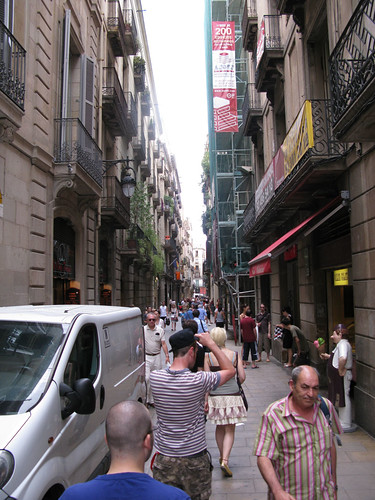
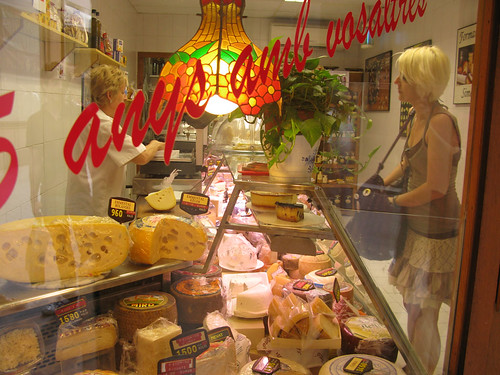
We walked all the way down to the port, and all the way back on La Rambla, stopping off along the way for refreshments, including beer at a microbrewery. Wearing my big clunky boots may have seemed like a stupid idea in Barcelona, but at least this long walk left me unscathed. One of the others with less sensible footwear wasn't quite so lucky, and by time we got back I was thinking we might have to amputate his foot, or at least feed him some beer, to ease any pain. The second option seemed to be more favoured, and went well with the spaghetti we'd thrown together for dinner.



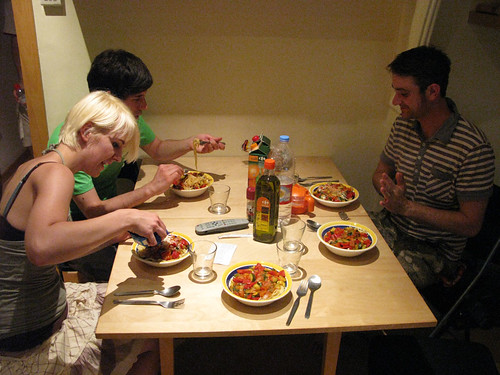
Monday morning starts a little hazily, probably as a result of Anke's delicious Baileys-style cocktails that we were drinking into the early hours of Sunday morning. It is still technically the morning after, as 3 hours sleep in a cheap and cheerful youth hostel in the centre of Camdon doesn't really count as a good night's sleep.
There are last minute preparations to be made, before I head out. Water the plants; check passport; learn Catalan; decide what we should do for this upcoming week... I didn't manage to do everything on my list before heading to the airport, but at least the plants didn't feel neglected.
I found out in the airport that politics is about as taboo as talking about the ethics of food, and the best thing to say about nationalism when surrounded by foreigners is nothing. Hypothesizing what would happen if lightning struck a plane in middair seemed to lighten the mood, until torrential rain delayed our plane from taking off.
And then we were off!
There weren't many hours left in the day by time we'd settled into our awesome apartment in the middle of Gràcia, so we didn't stray far for our first round of Estrellas, followed by some food from a place called Ugarit. There seemed to be a reasonable selection of Middle-Eastern-style food here, including falafels and cous cous, and I ended up with a wrap filled mostly with houmous, which is what you get when trying to stress how much you don't want any other sauces, "only houmous". The free shots of beer was a nice touch.



Day 2
We were all up bright and early in the morning, which was a nice change, and the first port of call was the supermarket for some supplies. We'd decided to do a bit of cooking in the apartment, to save on money, and also to accomodate my taste buds, which I definitely appreciated. It was either that, or drag my friends to a vegan restaurant (of which there are plenty in Barcelona), and have them complain about "organic tasting" or "bland" food, or worse, go to a regular restaurant, where I would inevitably get given genuinely bland and organic-tasting food, or simply food I couldn't/wouldn't eat. Cooking at home was definitely the best option, although I was slightly concerned about how much they really cared, when one of them decided to get some unsuitable pasta, saying it was probably OK because it didn't have pictures of eggs on the packaging like the others...



After depositing some extremely heavy shopping, and a quick mid-afternoon snack to keep us going, we headed back into the city making our way from the fountains at Catalunya Square to the Gothic Quarter.

Barcelona is a beautiful city to walk around. Each quarter has its own personality, and to me, the Gothic quarter is exactly how I imagined Barcelona to be, with its narrow cobbled alleys snaking their way around old churches, unique architecture, cafés and bars. Amongst the plethora of artisan bakeries, delicatessens and pharmacies, there just isn't any need for supermarkets. Buying from these tiny shops is a much more tangible experience than self service in a supermarket, or worse, internet shopping.


We walked all the way down to the port, and all the way back on La Rambla, stopping off along the way for refreshments, including beer at a microbrewery. Wearing my big clunky boots may have seemed like a stupid idea in Barcelona, but at least this long walk left me unscathed. One of the others with less sensible footwear wasn't quite so lucky, and by time we got back I was thinking we might have to amputate his foot, or at least feed him some beer, to ease any pain. The second option seemed to be more favoured, and went well with the spaghetti we'd thrown together for dinner.




Monday, May 25, 2009
Milk
"Why don't you drink milk?" and "Where do you get calcium from?", because of course, everyone knows that cow's milk is packed full off goodness... [1]
Calcium is an important mineral, essential for maintaining healthy bones. Cow's milk is usually cited as the number one source of calcium in a person's diet, thanks to some good advertising from people who make a lot of money off of the dairy industry. However it is the advertisment companies who encourage the population to make the leap from "dietry calcium is good for bones" and "milk contains calcium", to "milk is good for healthy bones". The paper that the Got Milk advertisment company cite for their heath claim linking milk to healthy bones makes no claims at all about the relationship between drinking milk and fending off osteoporosis. [2]
In fact, it is becoming increasingly obvious that cow's milk is a poor source of calcium among adults [3]
As infants, milk plays an important role in development, including the growth of bones. Cow's milk is unacceptable at an early age, due to its composition being suited for young calfs, and not human babies. As the child grows older, and starts eating solid food, the production of the enzyme responsible for breaking down lactose slows, and in many people, stops altogether, leaving the sugar undigested in the intestines. This can lead to a range of digestive complaints, as the micro-organisms living in the gut feed on the sugar, and producing unwanted toxins and byproducts due to fermentation. 75% of the world's adult population are lactose intolerant to some degree.[8]
Unsurprisingly, calcium is abundant from all kinds of different vegetables. After all, cows and other herbivores have to get it from somewhere right? Dark green leafy vegetables (except spinach, due to high levels of oxalic acid), broccoli being one of the best sources. Sesame seeds are another great source of calcium.
Ignoring milk's "niché" nutritional benifits, we are left with a questionable beverage. High levels of cholesterol and saturated fat, and a splattering of somatic cells (aka pus, which is found naturally in all mammal milk, but increased if that mammal has mastitis, as is often the case with dairy cows). To top all those unique selling points, Posilac, a hormone used to increase milk production in cows pushed the dairy industry into uncharted waters. As far as we know, milk may or may not contain byproducts due to this artifical hormone, which may have an effect on human heath. May. Who knows? Luckily its now a banned drug in the UK, but what will they come up with next to squeeze more money out of the dairy cash cow.
So the question should really be "Why would I want to drink milk?"
References
1.http://en.wikipedia.org/wiki/Calcium#cite_note-Weaver-17
2. http://www.gotmilk.com/pdf/715_s.pdf
3.http://www.thehealthierlife.co.uk/natural-health-articles/osteoporosis/calcium-rich-foods-00467.html
4. http://en.wikipedia.org/wiki/Milk
5. http://pediatrics.aappublications.org/cgi/content/full/116/4/921
6.http://www.fresh-network.com/acatalog/calcium-in-a-nutshell.html
7. http://www.trans4mind.com/nutrition/pH.html
8.Suarez FL, Savaiano DA: Diet, genetics and lactose intolerance. Food Technol 51:74-76, 1997
Calcium is an important mineral, essential for maintaining healthy bones. Cow's milk is usually cited as the number one source of calcium in a person's diet, thanks to some good advertising from people who make a lot of money off of the dairy industry. However it is the advertisment companies who encourage the population to make the leap from "dietry calcium is good for bones" and "milk contains calcium", to "milk is good for healthy bones". The paper that the Got Milk advertisment company cite for their heath claim linking milk to healthy bones makes no claims at all about the relationship between drinking milk and fending off osteoporosis. [2
In fact, it is becoming increasingly obvious that cow's milk is a poor source of calcium among adults [3]
As infants, milk plays an important role in development, including the growth of bones. Cow's milk is unacceptable at an early age, due to its composition being suited for young calfs, and not human babies. As the child grows older, and starts eating solid food, the production of the enzyme responsible for breaking down lactose slows, and in many people, stops altogether, leaving the sugar undigested in the intestines. This can lead to a range of digestive complaints, as the micro-organisms living in the gut feed on the sugar, and producing unwanted toxins and byproducts due to fermentation. 75% of the world's adult population are lactose intolerant to some degree.[8]
Unsurprisingly, calcium is abundant from all kinds of different vegetables. After all, cows and other herbivores have to get it from somewhere right? Dark green leafy vegetables (except spinach, due to high levels of oxalic acid), broccoli being one of the best sources. Sesame seeds are another great source of calcium.
Ignoring milk's "niché" nutritional benifits, we are left with a questionable beverage. High levels of cholesterol and saturated fat, and a splattering of somatic cells (aka pus, which is found naturally in all mammal milk, but increased if that mammal has mastitis, as is often the case with dairy cows). To top all those unique selling points, Posilac, a hormone used to increase milk production in cows pushed the dairy industry into uncharted waters. As far as we know, milk may or may not contain byproducts due to this artifical hormone, which may have an effect on human heath. May. Who knows? Luckily its now a banned drug in the UK, but what will they come up with next to squeeze more money out of the dairy cash cow.
So the question should really be "Why would I want to drink milk?"
References
1.
2. http://www.gotmilk.com/pdf/715_s.pdf
3.
4. http://en.wikipedia.org/wiki/Milk
5. http://pediatrics.aappublications.org/cgi/content/full/116/4/921
6.
8.
Sunday, May 24, 2009
Back To Basics
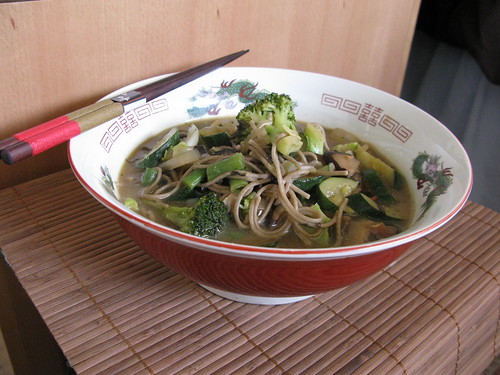
Most people go for ice cream, others go for a bottle of wine. My comfort food is a big bowl of noodle soup. Whether it be cold winter nights, long uni days, or just getting home from work at 9pm, a bowl of this never fails to hit the spot.
Soba noodles are my favourite, mainly for their taste, but also because I prefer to not eat wheat based staple for every meal. Clearspring do some nice 100% buckwheat noodles.
Noodles (serves 2)
1 bundle soba noodles (80g)
3 dried shitake
1 tbsp sunflower oil
1 onion
1 chili
3 cloves of garlic
1/2" piece of ginger
1/2 carrot
few slices of daicon
1 courgette
handful of broccoli florets
1 tsp soya sauce
1 tsp dark miso
1/2 tsp rice vinegar
2 tsp mirin
1 tsp sesame oil
Dried seaweed
- Rehydrate the mushrooms in a cup of hot water.
- Fry the onion, garlic, ginger and chili in the oil, for 4 minutes
- Finely slice the root vegetables, and add these with the soya sauce
- Add the chopped courgette, and broccoli, along with the liquid from the mushrooms. Bring to the boil.
- Add the miso paste, and stir until dissolves, then add the noodles.
- Bring back to the boil, then cover and simmer for 10 minutes.
- Add the vinegar, mirin, sesame oil, and seaweed, and stir in.
Sunday, March 22, 2009
Dinner Party
I woke up with a feeling that today was something to look forward to, and after eagerly checking my calendar, I discovered that dinner at a collegues's house was on the agenda. Not just any collegue, but the only other vegan in the entire of the company I work for.
Dinner with friends is one of my favourite activities for sure. I like food, and I like friends! But having friends cook for me, a rare occasion in itself, can sometimes be less than inspiring if they are having to cook differently to how they normally cook, just for me.
And its to be expected - I wouldn't expect a Mexican to be able to cook up a great bit of sushi for a Japanese guest, but he'd sure know how to make a damn fine burrito. Although don't get me wrong, I have had some truly delicious meals cooked up for me by some of my closest omniviouous friends.
Having a vegan couple cook up a dinner party is a different kettle of fish. Vegans know how to cook vegan, what tastes good, and what doesn't. How to make traditional dishes without just leaving out any non-vegan elements, but substituting in something that will work. How to get the most flavour out of food, without simply throwing salt it. Thats the advantage of eating healthily.
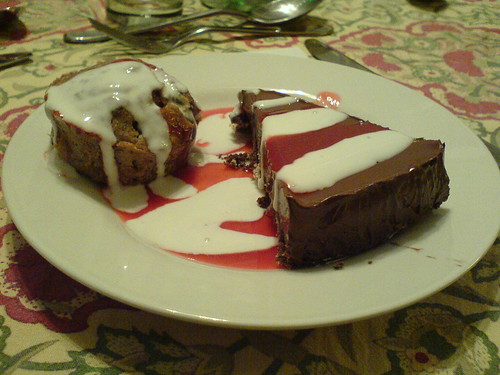
Enter the vegan dinner. This wasn't just your average one-pot meal for 6. This was a 3 course banquet, with printed menu and everything - the whole nine yards. And it was superb! For starters, we had falafels with tahini dressing, and salad, with pina-colada and puppodums to wet the appetite further. Then came a thai curry for the main meal. Followed by the simply wonderful chocolate torte, served with raspberry coulis and soya cream. We also had one of my quinoa and almond muffins that I'd baked earlier, which looked a little out of place amongst such royalty, but actually went quite nicely with the sauces!
So there you have it!
Dinner with friends is one of my favourite activities for sure. I like food, and I like friends! But having friends cook for me, a rare occasion in itself, can sometimes be less than inspiring if they are having to cook differently to how they normally cook, just for me.
And its to be expected - I wouldn't expect a Mexican to be able to cook up a great bit of sushi for a Japanese guest, but he'd sure know how to make a damn fine burrito. Although don't get me wrong, I have had some truly delicious meals cooked up for me by some of my closest omniviouous friends.
Having a vegan couple cook up a dinner party is a different kettle of fish. Vegans know how to cook vegan, what tastes good, and what doesn't. How to make traditional dishes without just leaving out any non-vegan elements, but substituting in something that will work. How to get the most flavour out of food, without simply throwing salt it. Thats the advantage of eating healthily.

Enter the vegan dinner. This wasn't just your average one-pot meal for 6. This was a 3 course banquet, with printed menu and everything - the whole nine yards. And it was superb! For starters, we had falafels with tahini dressing, and salad, with pina-colada and puppodums to wet the appetite further. Then came a thai curry for the main meal. Followed by the simply wonderful chocolate torte, served with raspberry coulis and soya cream. We also had one of my quinoa and almond muffins that I'd baked earlier, which looked a little out of place amongst such royalty, but actually went quite nicely with the sauces!
So there you have it!
Wednesday, March 4, 2009
The Queen Of Tarts
Not to be outdone easily, by the food venues of London, I decided to try my hand at one of my favourite desserts. This recipe has been optimized over the years by my Mum, originally coming from a big not-even-vegetarian hardback cookbook, which is so old that the front page has been bleached colourless by the sun.

Bakewell Tart
(makes 12)
For the pasty
Roll out dough, and cut into 12 circles. Place in shallow muffin tray, and bake at 160ºC for 10 minutes.
Meanwhile, make the filling. Melt margarine, and add the sugar. Cook for 1 minute, then leave to cool slightly. Add all the other ingredients, except the milk and jam, and combine. Add enough milk to get a dropping consistency.
Into each pastry case, add a teaspoon of jam, and cover with a tablespoon of the filling.
Bake for 25 minutes, at 160ºC, until golden brown.


Bakewell Tart
(makes 12)
For the pasty
- 6 oz (170 g) Plain Flour
- ¼ tsp Salt
- 1 ½ oz (40 g) Solid vegetable fat (Trex)
- 1 ½ oz (40 g) Margarine
- 1-2 tbsp Water
- 4 oz (110 g) Margarine
- 4 oz (110 g) Sugar
- 1 oz (30 g) Ground almonds
- 3 oz (90 g) Rice flour
- ½ tsp Almond essence
- 1 tsp Baking powder
- 1-2 tbsp Soya milk
- 4 tbsp Blackberry jam
Roll out dough, and cut into 12 circles. Place in shallow muffin tray, and bake at 160ºC for 10 minutes.
Meanwhile, make the filling. Melt margarine, and add the sugar. Cook for 1 minute, then leave to cool slightly. Add all the other ingredients, except the milk and jam, and combine. Add enough milk to get a dropping consistency.
Into each pastry case, add a teaspoon of jam, and cover with a tablespoon of the filling.
Bake for 25 minutes, at 160ºC, until golden brown.

Tuesday, March 3, 2009
Whats For Dessert?
Like a rollercoaster, the past few months have flown past, with plenty of ups and downs, and barely no time to stop and take stock. Wheeling and diving around the office has taken up most of the time, on this bumpy ride. Spiraling up towards the final milestone, there are still a few revolutions to make before it'll be finished, and I can jump off onto something a bit more relaxing.
All the extra time spent in the office has meant I've had to be a little more creative with my food, as dinner at home is becoming a luxury that I'm starting to miss.
On the flip side, being so busy during the week makes you really appreciate your spare time. Saturdays and Sundays are no longer spent idle, which would be a waste of such a precious commodity. Even staying in bed past 9 in the morning seems like a waste of time. Travelling to London is my favourite way of spending my weekend. There are so many nice places to look round, interesting people to meet, and plenty of restaurants that serve way more than the ubiquitous salad ala chips.
I've discovered that a slice of cheesecake is an activity in itself. I've never liked the sound of this particular dessert. Two seemingly incompatible things rolled into one word, sounds about as appetizing as curry flavoured fruit smoothie. However, not wanting to judge a book by anything less than the words within, I took the plunge, starting with a slice of Inspiral's rasberry cheesecake.
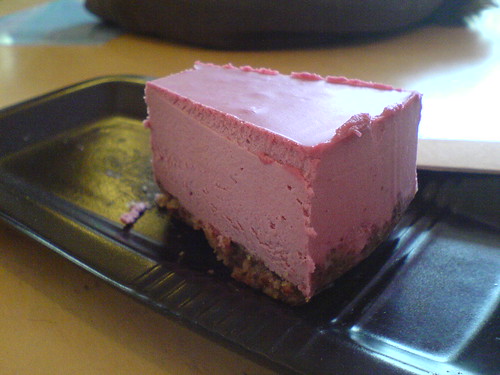
And oh my! It's cool velvety berry filling melted instantly in my mouth, like icecream. Not too sweet, which made it quite easy to knock back, and it sure hit the spot.
Next up on the hitlist, from the same venue, was the tiramisu:
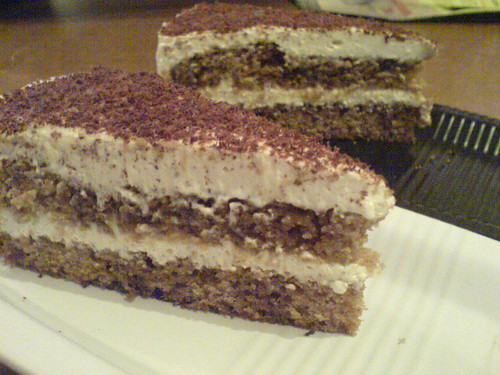
This had a distinct coffee type flavour, and is apparently one of their most popular numbers. Personally, it was my least favourite of the bunch - the white layers tasted a bit like raw sugar mixed with margarine, sandwiching together damp coffee infused hobnob crumbs. I'm guessing that's probably what it was, which was slightly dissapointing at £3.20 a slice.
Finally I made it to Mildreds for the somewhat pricier Chocolate and Raspberry Truffle Torte, weighing in at just under £5.
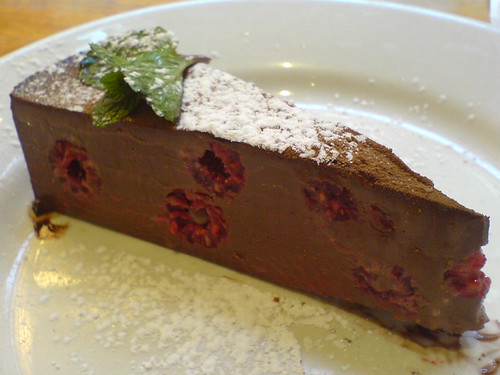
This one was totally worth every penny, and blew the others out of the water. Similar in texture to the rasberry cheesecake, but with a much more intense chocolate flavour, it was the clear winner. My only complaint with this one, besides the inevitably slow table service, in this ever-busy restaurant, was the icing sugar. Made it look pretty, sure, but made every bite quite treachourous, if you accidentally breathed in too much whilst eating it. Icing sugar in the lungs isn't the most pleasurable of experiences.
All the extra time spent in the office has meant I've had to be a little more creative with my food, as dinner at home is becoming a luxury that I'm starting to miss.
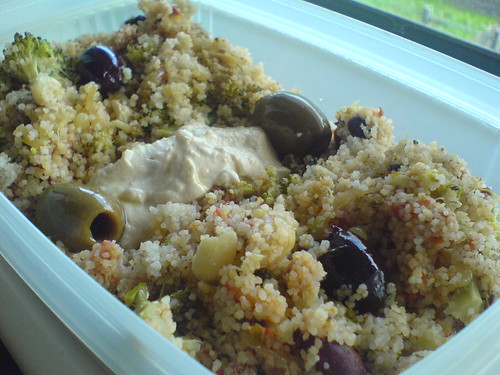 |  |
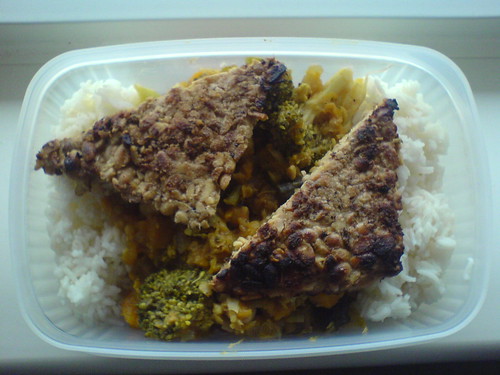 | 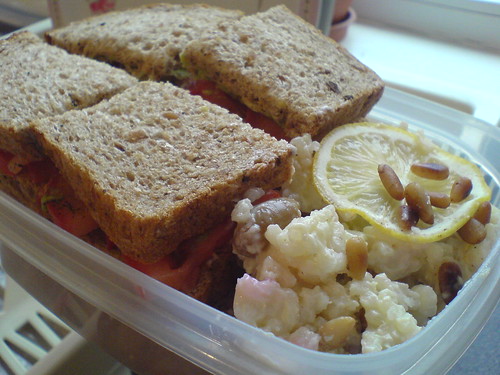 |
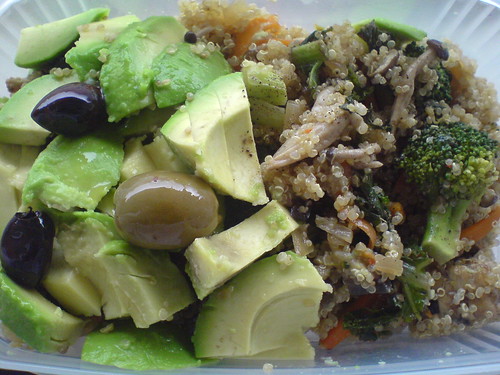 | 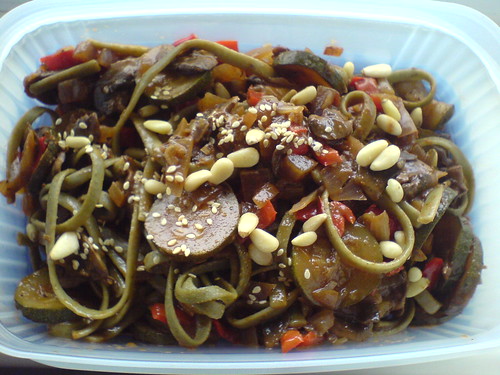 |
On the flip side, being so busy during the week makes you really appreciate your spare time. Saturdays and Sundays are no longer spent idle, which would be a waste of such a precious commodity. Even staying in bed past 9 in the morning seems like a waste of time. Travelling to London is my favourite way of spending my weekend. There are so many nice places to look round, interesting people to meet, and plenty of restaurants that serve way more than the ubiquitous salad ala chips.
I've discovered that a slice of cheesecake is an activity in itself. I've never liked the sound of this particular dessert. Two seemingly incompatible things rolled into one word, sounds about as appetizing as curry flavoured fruit smoothie. However, not wanting to judge a book by anything less than the words within, I took the plunge, starting with a slice of Inspiral's rasberry cheesecake.

And oh my! It's cool velvety berry filling melted instantly in my mouth, like icecream. Not too sweet, which made it quite easy to knock back, and it sure hit the spot.
Next up on the hitlist, from the same venue, was the tiramisu:

This had a distinct coffee type flavour, and is apparently one of their most popular numbers. Personally, it was my least favourite of the bunch - the white layers tasted a bit like raw sugar mixed with margarine, sandwiching together damp coffee infused hobnob crumbs. I'm guessing that's probably what it was, which was slightly dissapointing at £3.20 a slice.
Finally I made it to Mildreds for the somewhat pricier Chocolate and Raspberry Truffle Torte, weighing in at just under £5.

This one was totally worth every penny, and blew the others out of the water. Similar in texture to the rasberry cheesecake, but with a much more intense chocolate flavour, it was the clear winner. My only complaint with this one, besides the inevitably slow table service, in this ever-busy restaurant, was the icing sugar. Made it look pretty, sure, but made every bite quite treachourous, if you accidentally breathed in too much whilst eating it. Icing sugar in the lungs isn't the most pleasurable of experiences.
Subscribe to:
Posts (Atom)
